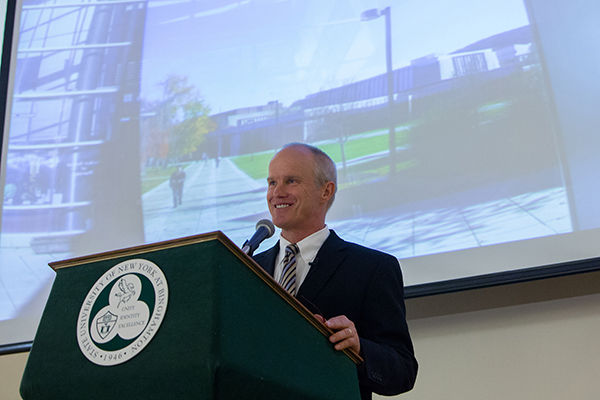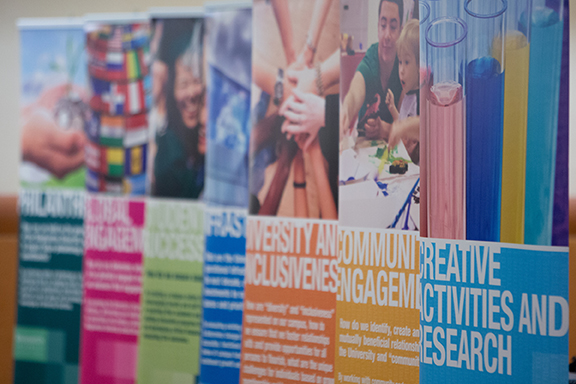Road Map helps charter a course to campus success
A decade of collaborative projects enable Binghamton University to grow, thrive

A decade ago at Binghamton University, the words road map became more than a descriptor for a large, folded paper that can never be refolded correctly once opened.
With the launch of the University’s Road Map to Premier strategic plan in spring 2013 — an undertaking that had evolved over several months with the help of more than 400 volunteers and four student interns — the words road map became a true outline for the University’s future.
Road Map project impacts over the past 10 years range from creation of the School of Pharmacy and Pharmaceutical Sciences and expansion of the Decker School of Nursing into Decker College of Nursing and Health Sciences, to creation of the Division of Diversity, Equity and Inclusion and enhancing infrastructure and instrumentation for research and creative activities.
The Road Map implementation launch was held April 8, 2013, in the Mandela Room of The Union.
“I remember thinking ‘This is a big commitment,’” says University President Harvey Stenger. “You’ve worked with more than 400 people for six months. You have some results and you’re going to present it to them and rest of the world? You can’t second-guess now!
“That launch was the turning point,” Stenger adds. “If we didn’t have enthusiasm and momentum from these volunteers who had worked so hard, we wouldn’t have gone anywhere.”
Instead, the Road Map became akin to a GPS signal, guiding the University since its launch and through regular updates: the Road Map Renewal kicked off in December 2016; Re-Aiming the Road Map in 2021; another update is underway.
Stenger set the Road Map process in motion in spring 2012, when he put out a call for volunteers in nine areas and asked people to pick their top three. That summer, four undergraduate students — Matt Austin, Becca Platsky, Ganna Veresotska and Bill Landis — came on board as interns and took on the task of reviewing all the volunteer requests and assigning people to the teams.
“The interns worked really hard on getting the teams right,” Stenger says. “They continually reminded me that our vision was to be the premier public university and we get to decide what premier is. For us, premier means excellence, accountability, balance and pride.”
Averting chaos
Involving more than 400 volunteers was a risk, says Donald Nieman, who became executive vice president for academic affairs and provost as the volunteers were being slotted into the nine working teams.
“The engagement was incredible, but when I look back on it, it was a really dangerous thing to do because when you involve that many people, you run the risk of chaos,” Nieman says. “It was a dicey thing for a new president to do, but Harvey would always say ‘I didn’t go to president school.’”
In fact, Stenger, who spent 23 years at Lehigh University earlier in his career, says he learned the value of true collaboration from watching Lehigh’s president seek as much information as possible before making any decisions.
“So when I got here, I used the collaborative, all-hands-on-deck process,” he says.
The potential for chaos was averted at Binghamton by bringing structure to the process, says Pam Mischen, who was teaching public administration at the College of Community and Public Affairs (CCPA) when teams were being formed.
“Pat Ingraham was the dean of CCPA and told Harvey that I would make a good co-chair of a team because I understand strategic planning,” Mischen says. “That’s how I got into one of the original nine teams and that’s how I met Harvey.”
In fall 2012, Mischen took on the role she still holds as faculty advisor to Stenger, and became fully immersed in the Road Map. That was also when the President’s Reception Room in the Anderson Center became the “war room” where easels abounded and planning took place.
“Pam became the backstage manager, and that helped a lot,” Stenger says. “She knew the difference between a goal and an objective.”
And helping the team co-chairs set goals was something Mischen and her Master in Public Administration (MPA) students did. She was teaching a performance measurement course at the time and suggested to Stenger that her class help the Road Map teams develop goals as a class project.
“Harvey came to a class and explained to my MPA students that they would be assigned to one of the strategic priorities and they would learn how to write goals and objectives,” Mischen says. “Then they would teach that process to the co-chairs and the teams would come up with their own goals.
“It was a great experience for the students — a confidence builder — to teach high-level administrators a skill,” Mischen says. “And that’s how we developed a set of goals for the strategic priorities.
“The goal statements had to reflect an ideal and not necessarily be achievable,” Mischen adds. “Metrics need to be ambitious but realistic, but goal statements should be the ideal and reflect outcomes, not things to do. It’s not about what are we going to do, but about what do we want to be.”
Ambitious projects align with priorities
As teams set goals and coalesced, Stenger put out a call for proposals for what he called 3-I projects — initiatives, innovations, ideas — that would help the University reach the goals established by the teams.
The initial projects would be funded through the NYSUNY 2020 Challenge Grant program, which, for Binghamton, included $20 million from New York state, $15 million from SUNY and funds from other sources. Binghamton’s priorities were to fund construction of a health and natural sciences building; expand the University’s academic mission and grow enrollment by 2,000 students; strengthen existing partnerships and new collaborations with industry and others; and make an economic and community impact.
“It was important to use the NYSUNY 2020 funds in ways that the strategic priorities allowed us to,” Nieman says. “We’d been so starved and were in sorry shape from a staffing standpoint, but our steering committee discussions helped us, and they convinced people that we were putting our money where the strategic priorities best indicated.”
As proposals were reviewed and ranked by the Road Map Steering Committee — 176 were received and 43 of those were funded — keeping everything manageable also meant moving from nine original teams to five strategic priorities, something Nieman calls absolutely imperative.
“It’s like trying to hit a sweet spot where we have enough focus that we can say ‘This is really strategic,’” he says. “Nine would be diluted, and as a matter of resource allocation, it’s like spreading the peanut butter too thinly across the toast.”
Dozens of projects were funded after the initial round: 10 in 2015–16; 14 in 2016–17; and 27 in 2017–18. Combined with strategic faculty hiring, the development of the Transdisciplinary Areas of Excellence (TAEs) and cluster hiring in the TAE areas of focus, the projects moved the University forward in ways that aligned with the established strategic priorities.
And as the Road Map guided the campus it continued to be a credible, participatory, transparent process where people were listened to, Nieman says.
“Things change so we have been able to pivot. The 2017 renewal pivot was critical because of the end of NYSUNY 2020. We were in a different financial environment, but we had an explosion of data science that allowed us to readjust the Road Map to new circumstances. We did it again when we re-aimed the Road Map and added the internationalization sixth priority in the wave of the pandemic.”
As for funding of major projects, New York state came through with funding for the School of Pharmacy and Pharmaceutical Sciences; the Upstate Revitalization Initiative enabled expansion of the Health Sciences Campus to include Decker College of Nursing and Health Sciences; and a broad partnership between the University, the Binghamton University Foundation, New York state, SUNY Broome Community College, Broome County, the city of Binghamton, the federal government and private-sector and industry partners brought the Koffman Southern Tier Incubator to fruition.
Embedding key values
Ultimately, Nieman says, the focus was on maintaining the quality of undergraduate education through things like investment in the Center for Learning and Teaching while finding ways to tie research to enhancement of undergraduate teaching through programs such as the First-year Research Immersion program and the Source Project.
“We did what we had to do to increase our research standing without leaving undergraduate education in the lurch,” he says. “That is a huge success and, I would argue, absolutely critical to the reputation of this institution.”
The Road Map also pushed the University to put its values and resources into making the campus more diverse and inclusive, Nieman adds. “That, and becoming more engaged with our community and less of an ivory tower as we fulfill our responsibility as a public university to serve the public good, is a powerful legacy.
“One of the measures of success of our strategic priorities,” Nieman says, “is that they lead you to change your behaviors and the way you deploy your resources. One of the best examples for us is diversity. From the get-go, we began investing more resources in diversity and that resulted in a new division. That was a pivotal moment and it has served us very, very well.”
“It took us time to ingrain this process in the University and how we think about things,” Mischen says. “Harvey has done a great job of keeping the Road Map front and center and it really has been the guiding document about how we manage the University. We’ve institutionalized it.”
For Stenger, empowering people who wanted to see change has been the most important outcome, and it happened in part by having the right people to enact the change.
“A lot of this was led by Don [Nieman] and he chose great people,” Stenger says. “We have a School of Pharmacy and Pharmaceutical Sciences, an expanded Decker College of Nursing and Health Sciences, an incubator. These are just some examples of what we’ve accomplished and they all arose from a vision that we could, and should, make them happen on our path to premier.
“The Road Map continues to guide decisions on a daily basis, but the guidance has become more instinctive,” Stenger says, “and that’s the way it should be!”
As the Road Map continues to evolve, the steering committees for each of the six strategic priorities have updated their metrics to reflect progress and establish the next bar to strive for, and a revamped website with the new metrics has been launched.



